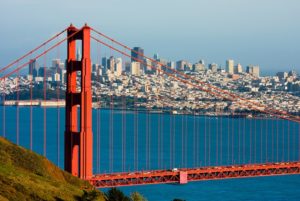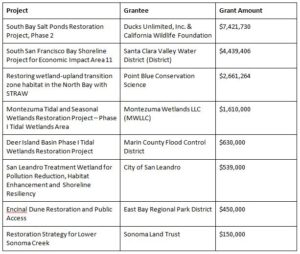On April 11, 2018, the Governing Board of the San Francisco Bay Restoration Authority, the local agency responsible for allocating funding raised by Measure AA, approved nearly $18 million in grants for wetland restoration in the Bay.
Measure AA, the San Francisco Bay Clean Water, Pollution Prevention and Habitat Restoration Measure, was passed in June of 2016 by 70% of voters in the nine Bay Area counties. The measure is a $12 parcel tax that is generating approximately $25 million annually, or $500 million over twenty years, to fund shoreline restoration.
In a time when many Americans are demanding a greater nation, but are unwilling to pay the taxes necessary to make that happen, San Francisco voters have set an national example of citizen responsibility.
Rather than opting for the currently popular “freeloader” approach that merely hopes someone else will improve the country, the folks in San Francisco demonstrated that they really care about their children’s future: it’s not just “family values” rhetoric for them.
As Supreme Court Chief Justice Oliver Wendell Holmes, Jr. said, “Taxes are the price we pay for civilization. I like to pay taxes. With them I buy civilization.” Or, in this case, it buys restoration.
“We are so grateful to Bay Area voters, who cherish the Bay and voted to tax themselves to protect and restore it,” said San Mateo County Supervisor Dave Pine, Chair of the Governing Board for the Restoration Authority. “This is the start of a new era for Bay restoration. For the first time, we have a reliable source of substantial year-on-year funding, which will allow for the long-term planning and implementation that is necessary for large-scale restoration. And large-scale restoration is what we need to restore our Bay in the face of climate change.”
One of the primary recipients of this funding will be the effort will be the restoration of the Cargill salt ponds at the south end of the bay. This has been a long time coming: I (Storm Cunningham) wrote about it in my first book, The Restoration Economy (Berrett-Koehler, 2002), which I started writing in 1996. The salt ponds comprise the largest wetland restoration project in the bay.
Over 16,000 acres of diked ponds will be restored gradually to both tidal and non-tidal marsh, replenishing the tattered San Francisco Bay ecosystem. It will also expand the San Francisco Bay National Wildlife Refuge, thus increasing recreation opportunities for local residents and improving the region’s quality of life. Restoration will greatly increase valuable habitat for endangered waterfowl, shorebirds, and fish.
The eight grants approved provide multiple benefits, and prioritize nature-based solutions to create flood protection and public access, in addition to the primary aim of restoring habitat and natural processes.
“We are very excited to put some serious funding behind these projects and future rounds,” said Sam Schuchat, Executive Officer of the Restoration Authority. “A healthy San Francisco Bay needs at least 100,000 acres of tidal wetlands to maintain our ecological diversity and adapt to climate change, but at present there are only 44,000 acres. Our changing climate is already impacting California and we must accelerate this restoration work now.”
The San Francisco Bay Restoration Authority is a regional agency charged with raising and allocating local resources for the restoration, enhancement, protection, and enjoyment of wetlands and wildlife habitat in San Francisco Bay and along its shoreline, and associated flood management and public access infrastructure.
The Restoration Authority was created by the California Legislature in 2008 to find solutions to the need for new, local funding, due to reduced funding from other sources. Its enabling legislation gives the Restoration Authority the unique capacity to raise funds from local sources throughout the Bay Area and the oversight capacity to ensure transparency and prevent waste. Its purpose is restoration, not regulation.
Featured photo of Cargill salt ponds via BoredPanda on Pinterest.



